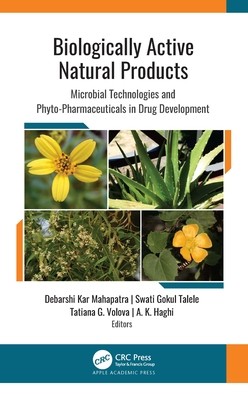
- We will send in 10–14 business days.
- Publisher: Apple Academic Press
- ISBN-10: 1771889047
- ISBN-13: 9781771889049
- Format: 15.5 x 23.9 x 2.3 cm, hardcover
- Language: English
- SAVE -10% with code: EXTRA
Biologically Active Natural Products (e-book) (used book) | bookbook.eu
Reviews
Description
Biologically active natural products and their substructures have long been valuable starting points for medicinal chemistry and drug discovery. This new volume explores biologically active natural products and their use in microbial technologies and as phyto-pharmaceuticals in drug development. It presents detailed scientific principles and recent research on applications of nanotechnology in diagnostics and drug delivery.
Topics include pharmacotherapeutically active proteins and peptides; the biotechnological potential of hydrogen-oxidizing bacteria; synthesis and production; synthetic colorants, pigments, dyes, and lakes; and more. The use of various plants is discussed in several chapters, including Artemisia, Asteraceae, Abutilon indicum, Prosopis juliflora, Acacia arabica, Aloe barbadensis, Tabermontana divaricate Linn., among others.
With the information presented in Biologically Active Natural Products: Microbial Technologies and Phyto-Pharmaceuticals in Drug Development, scientists, faculty, and graduate students will gain a unique insight into nanotechnology and natural pharmaceuticals today with practical implementation in various industrial sectors.
EXTRA 10 % discount with code: EXTRA
The promotion ends in 19d.21:39:46
The discount code is valid when purchasing from 10 €. Discounts do not stack.
- Publisher: Apple Academic Press
- ISBN-10: 1771889047
- ISBN-13: 9781771889049
- Format: 15.5 x 23.9 x 2.3 cm, hardcover
- Language: English English
Biologically active natural products and their substructures have long been valuable starting points for medicinal chemistry and drug discovery. This new volume explores biologically active natural products and their use in microbial technologies and as phyto-pharmaceuticals in drug development. It presents detailed scientific principles and recent research on applications of nanotechnology in diagnostics and drug delivery.
Topics include pharmacotherapeutically active proteins and peptides; the biotechnological potential of hydrogen-oxidizing bacteria; synthesis and production; synthetic colorants, pigments, dyes, and lakes; and more. The use of various plants is discussed in several chapters, including Artemisia, Asteraceae, Abutilon indicum, Prosopis juliflora, Acacia arabica, Aloe barbadensis, Tabermontana divaricate Linn., among others.
With the information presented in Biologically Active Natural Products: Microbial Technologies and Phyto-Pharmaceuticals in Drug Development, scientists, faculty, and graduate students will gain a unique insight into nanotechnology and natural pharmaceuticals today with practical implementation in various industrial sectors.


Reviews